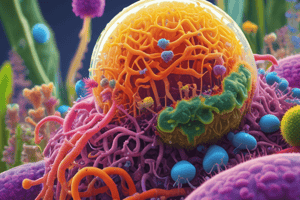Podcast
Questions and Answers
What are abiotic factors in a habitat?
What are abiotic factors in a habitat?
- Non-living environmental factors like water and soil (correct)
- Living organisms and their interactions
- Biotic components including plants and animals
- Symbiotic relationships among species
How does a mutation become an adaptation?
How does a mutation become an adaptation?
- It increases the chances of survival in a habitat (correct)
- It causes a decrease in reproductive success
- It results in the species becoming extinct
- It leads to a reduction in competition
What does a niche represent in an ecosystem?
What does a niche represent in an ecosystem?
- The complex interactions of a species within its environment (correct)
- The genetic variety within a species
- The species' ability to control abiotic factors
- Only the physical space where a species lives
In the tolerance range graph, what does the central peak indicate?
In the tolerance range graph, what does the central peak indicate?
What happens to a species population when an abiotic factor exceeds its tolerance range?
What happens to a species population when an abiotic factor exceeds its tolerance range?
What do marginal niches represent on the tolerance range graph?
What do marginal niches represent on the tolerance range graph?
Which factor is identified as a biotic component of a habitat?
Which factor is identified as a biotic component of a habitat?
What is the process called when mutations contribute to the evolution of a species?
What is the process called when mutations contribute to the evolution of a species?
Flashcards
Habitat
Habitat
The place where an organism lives, including both living (biotic) and non-living (abiotic) factors.
Biotic factors
Biotic factors
Living things in a habitat, such as plants, animals, bacteria, or their waste products.
Abiotic factors
Abiotic factors
Non-living things in a habitat, such as water, soil type, and climate.
Tolerance range
Tolerance range
Signup and view all the flashcards
Optimum range
Optimum range
Signup and view all the flashcards
Mutation
Mutation
Signup and view all the flashcards
Adaptation
Adaptation
Signup and view all the flashcards
Niche
Niche
Signup and view all the flashcards
Study Notes
Habitat Requirements for Species
- A habitat is the place where a species lives, including both biotic (living) and abiotic (non-living) factors
- Biotic factors include plants, animals, bacteria, and waste products
- Abiotic factors include water, soil type, and climate
- Every species has a tolerance range for abiotic factors; populations die outside this range
- The optimal value of an abiotic factor is where the largest number of individuals of a species is found
Mutations and Adaptation
- Mutations create differences in the DNA of individuals
- An adaptation is a mutation that enhances survival in a specific habitat
- Organisms with adaptations have higher fitness (more offspring)
- This increased rate of organisms with the adaptation leads to an increase in the likelihood of the adaptation continuing
- Natural selection is the process where these adaptations become more common over time
Species Niches
- A niche describes the complex interactions of a species within its environment, including its role or function
- A species' niche can be seen as the role or function it has in the ecosystem
- Different species can co-exist in the same ecosystem by occupying different niches, avoiding competition
Studying That Suits You
Use AI to generate personalized quizzes and flashcards to suit your learning preferences.





